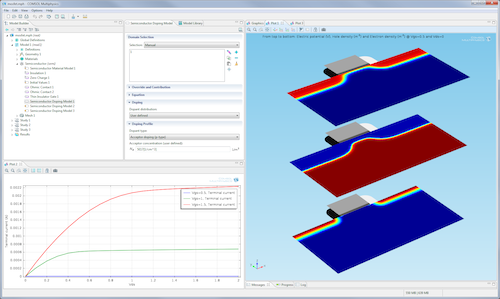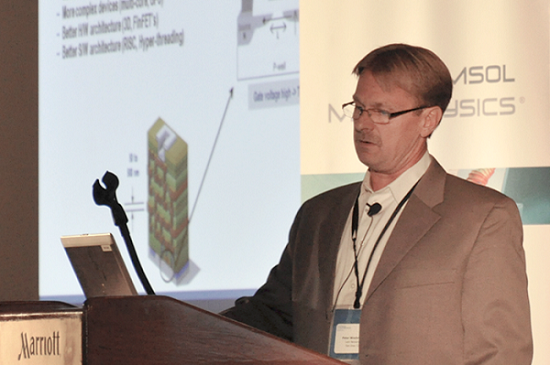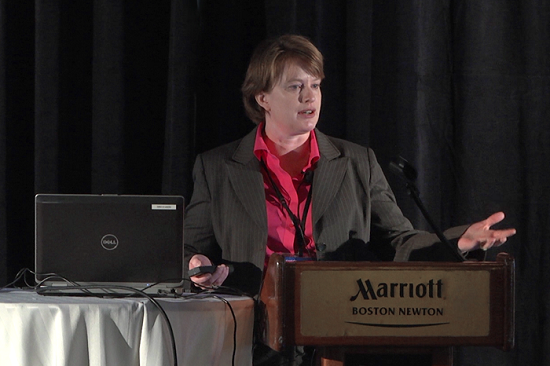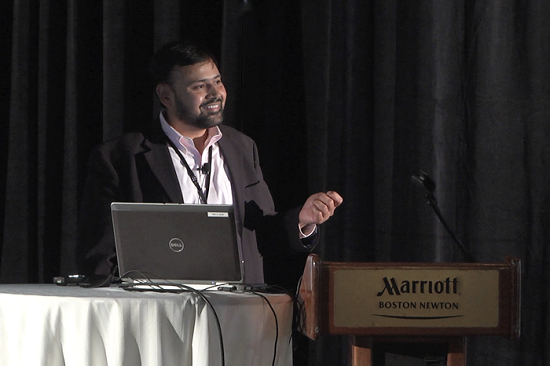Latest News
October 17, 2013
What do Moore’s Law, structural corrosion, and magnetostrictive transducers have in common? Seemingly, not much. Yet at the recent COMSOL 2013 Conference in Boston, they were showcased as three real-world examples of open-ended design challenges being effectively explored in the virtual world using COMSOL multiphysics.
While the three keynote speakers are pursuing design problems that appear to be world’s apart, they are indicative of a shared goal among COMSOL’s growing user base: That is, an obsession with accuracy and a desire to skip or cut back on physical testing, which is far more time-consuming and expensive than virtual prototyping, according to Valerio Marra, COMSOL’s technical marketing manager.
If there is any common thread amongst COMSOL’s user base, “it’s a desire for real-world accuracy and a chance to mimic real-world results,” Marra says. “How many cool ideas don’t see the light of day because there is no good tool to test them? This is why we invest in multiphysics because our customers want to reduce the number of prototypes and are obsessed with getting good results.”
Moore’s Law and Computational Modeling
At the conference, COMSOL’s trio of showcased customers seemed to bear that out. Peter Woytowitz, who leads the Computational Modeling and Reliability group in Central Engineering at Lam Research Corp., a supplier of wafer fabrication equipment and services, was first up. He presented on using COMSOL to explore the symbiotic relationship between Moore’s Law, which dictates that the number of transistors on integrated circuits doubles every 18 months, and computational modeling.
While it’s a known fact that Moore’s Law is a driver for the use of computational modeling, Woytowitz set out to explore how computational modeling in turn, enables Moore’s Law, helping to promote progressively higher transistor densities, better architectures, and increased reliability and speed. Using COMSOL Multiphysics, his research was able to explore wafer fabrication equipment modeling, IC device-level modeling, and eventually molecular dynamics, all in an effort to see how modeling can advance semiconductor design.
When to Stay with Single Physics Modeling
As part of her presentation on how multiphysics models are used in magnetostrictive transducer design, Julie Slaughter, a senior engineer at Extrema Products Inc., provided some insight into where different domain models and physics couplings come into play as part of the design process. For example, Slaughter says the team uses single physics modeling during the detailed design stage, but then turns to coupled models as part of the design validation process.
“We don’t like to do coupled models during detailed design because it adds a lot of complexity to the system that you don’t need at that point,” she explained during her presentation.
Comprehensive Corrosion Modeling
The third COMSOL user presenter was Dr. Siddiq Qidwai, mechanical engineer at the Multifunctional Materials Branch of the U.S. Naval Research Laboratory. Qidwai’s research was all about leveraging COMSOL to explore structural corrosion, which he called a formidable problem for both the naval and maritime industries. As part of his presentation, Qidwai said that the cost of corrosion to the general populace constitutes about 2% to 4% of the U.S. gross national product—an astounding figure and a hard one to ignore.
Qidwai said that the comprehensive modeling of corrosion requires the coupling of electrochemical relations and balance of mass involving multiple species; constitutive descriptions of reaction rates and species diffusion mechanisms in the electrolyte; and conditions governing the movement of metal-electrolyte interface. Using COMSOL Multiphysics, Qidwai’s team takes a gradual approach to this highly complex modeling agenda, going from simpler to complex phenomena, to investigate the effect of microstructure on corrosion pit growth and the subsequent effect on mechanical performance.
COMSOL 4.4 Debuts
In addition to showcasing diverse use cases for COMSOL, the company showed off its latest investment in multiphysics modeling—COMSOL version 4.4. While the upgrade adds a smattering of user-requested capabilities across many of its modules, there are a couple of major highlights. One is the revamped user interface that delivers a Windows look and feel, including the addition of the Microsoft ribbon for easier and faster access to functionality and to keep users versed in Microsoft Office products working in a familiar way. “Instead of spending time getting familiar with the COMSOL interface, users can now spend more time understanding their problem,” COMSOL’s Marra said. While new users will likely gravitate to the Microsoft-style ribbon interface, COMSOL is retaining its traditional model builder interface for existing users who might be more comfortable with that approach.
The other major addition to COMSOL 4.4 is the Mixer Module, an add-on to the CFD Module that is designed to help users understand and design the operation of mixers in the pharmaceutical, fine chemical, and food industries. This new module, one of many highly vertical add-ons COMSOL has announced in the last few years, provides full-moving mesh technology, free surface modeling, and a number of ready-made applications to help engineers explore laminar and turbulent reacting flows in rotating machinery.
These new features, along with capabilities in the main package designed to make multiphysics coupling easier, are all part of the vision to bring real-world accuracy to multiphysics modeling. “It’s challenging because our users have so many different needs, but there are some common threads,” Marra said. “They all want to increase time to market, save resources, and are obsessed with getting good results.”
COMSOL has produced a video overview of its global conference series, which you can view below.
Subscribe to our FREE magazine, FREE email newsletters or both!
Latest News
About the Author
Beth Stackpole is a contributing editor to Digital Engineering. Send e-mail about this article to [email protected].
Follow DE









